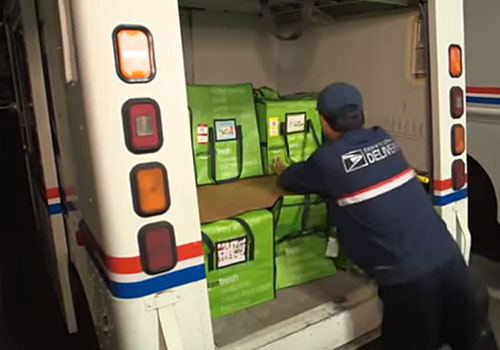
US Postal Service plans to overhaul delivery network
The U.S. Postal Service plans to close dozens of facilities across the country as part of a major reorganisation, a move that could save millions of dollars and create a more flexible postal network. But the plan is certain to spark a fresh round of bickering with the agency’s strong labor unions.
Last month, the agency released a plan for overhauling its delivery network. The so-called network report calls for closing airport mail facilities, consolidating bulk mail centers and streamlining the computer software that maps postal routes. The closures could lead to the elimination of hundreds of jobs and more outsourcing.
Postal officials say the changes will help revitalize a decades-old network.
The first facilities to close under the network plan are the airport mail centers (AMCs), which transfer mail between distribution centers and commercial airlines working under contract with the Postal Service.
Up until a few years ago, the Postal Service had mail contracts with more than a half-dozen carriers at many airports, and the centers were hubs of activity. But the agency has consolidated its contracts: At many airports, only one or two carriers handle mail. That means less work for the AMCs.
The Postal Service is also trying to ship less volume through the airlines because of rising fuel costs and increasing delays at many airports.
The Postal Service has closed 54 AMCs under a consolidation plan dating back to 2006. Williamson expects “a few” AMCs to keep running, but he couldn’t say how many or which ones. The agency expects to save USD 117 million between now and 2009 through reduced work hours and lease expenses.
And now the agency is starting another round of consolidations at its 400-plus mail processing facilities. The Postal Service will spend two years soliciting expert study and public opinion to decide which facilities to close. The U.S. Postal Service plans to close dozens of facilities across the country as part of a major reorganization, a move that could save millions of dollars and create a more flexible postal network. But the plan is certain to spark a fresh round of bickering with the agency’s strong labor unions.
Last month, the agency released a plan for overhauling its delivery network. The so-called network report calls for closing airport mail facilities, consolidating bulk mail centers and streamlining the computer software that maps postal routes. The closures could lead to the elimination of hundreds of jobs and more outsourcing.
Postal officials say the changes will help revitalize a decades-old network.
The first facilities to close under the network plan are the airport mail centers (AMCs), which transfer mail between distribution centers and commercial airlines working under contract with the Postal Service.
Up until a few years ago, the Postal Service had mail contracts with more than a half-dozen carriers at many airports, and the centers were hubs of activity. But the agency has consolidated its contracts: At many airports, only one or two carriers handle mail. That means less work for the AMCs.
The Postal Service is also trying to ship less volume through the airlines because of rising fuel costs and increasing delays at many airports.
The Postal Service has closed 54 AMCs under a consolidation plan dating back to 2006. Williamson expects “a few” AMCs to keep running, but he couldn’t say how many or which ones. The agency expects to save USD 117 million between now and 2009 through reduced work hours and lease expenses.
And now the agency is starting another round of consolidations at its 400-plus mail processing facilities. The Postal Service will spend two years soliciting expert study and public opinion to decide which facilities to close.
The final wave of consolidation will affect the Postal Service’s 21 bulk mail centers (BMCs). Those facilities sort large containers of mail. Since many high-volume mailers do their own sorting, the BMCs are operating well below capacity. Many have reduced their operations, from 24 to 16 hours a day, and others have shut down weekend operations.
Many BMCs are in major metropolitan areas, ideal locations to deploy new technology like the Flats Sequencing System (FSS), which rapidly sorts mail by carrier route. So the Postal Service hopes to outsource some of the BMC sorting functions to private companies, freeing up space to install the new equipment.
A spokesman for the National Postal Mail Handlers Union, which represents about 50,000 employees, said it has not reviewed the report and declined to comment. But, in a news release, the union said it would “vigorously oppose” the outsourcing efforts in the plan.
The American Postal Workers Union had a similar reaction, describing the network plan as the latest in a string of labor disputes.
The Postal Service has tried to blunt the impact of the closures and consolidations. Williamson said many employees would be given the option to move to other jobs. The network plan proposes to reduce the work force through buyouts and attrition.
Ultimately, though, the plan aims to create a leaner Postal Service, with a more efficient network. Murray Comarow, who served as executive director of the commission responsible for restructuring the Postal Service in 1971, said network efficiencies could help make the Postal Service a more attractive mailer, and boost its sagging business.
But politics could interfere with the plan. The 2008 appropriations bill prohibited the Postal Service from consolidating in several locations until the Government Accountability Office conducts a study; Williamson hopes the study will be finished next month. The consolidation could save USD 14 million annually.












